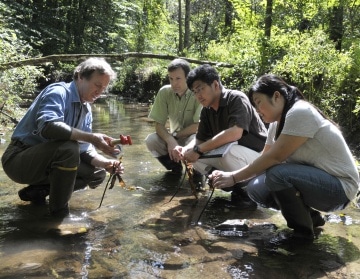FOR IMMEDIATE RELEASE: September 29, 2009
NEWS RELEASE

From left, Louis Kaplan, Anthony Aufdenkampe , Kyungsoo Yoo, and graduate student Chunmei Chen analyze samples from White Clay Creek. Photo by Evan Krape.
The University of Delaware, in collaboration with Stroud Water Research Center has received a $4.3 million grant from the National Science Foundation to establish the Christina River Basin as a “Critical Zone Observatory” for researching questions relating to climate change.
Scientists define the “critical zone” as the portion of the planet from the treetops to the groundwater that sustains terrestrial life.
The new Critical Zone Observatory at the University of Delaware joins five other such observatories in the United States — based at Pennsylvania State University, the University of Pennsylvania, University of Arizona, University of Colorado, and University of California– Merced. It is funded through a competitive, fiveyear grant awarded by the National Science Foundation (NSF) as part of the American Recovery and Reinvestment Act.
Donald Sparks, S. Hallock du Pont Chair in Soil and Environmental Chemistry and director of the Delaware Environmental Institute at UD, will lead the effort, which involves a multidisciplinary team of scientists.
Sparks’s co-principal investigators on the grant include Kyungsoo Yoo, assistant professor of plant and soil sciences, and James Pizzuto, professor of geological sciences, both at UD; and Anthony Aufdenkampe, assistant research scientist, and Louis Kaplan, senior research scientist, both at Stroud Water Research Center.
The research team also includes Shreeram Inamdar, associate professor of bioresources engineering; Delphis Levia, associate professor of geography; Yan Jin, professor of plant and soil sciences; Paul Imhoff, professor of civil and environmental engineering; Holly Michael, assistant professor of geological sciences; and Dominic DiToro, Edward C. Davis Professor of Civil and Environmental Engineering — all from UD; senior research scientists Denis Newbold and Tom Bott at Stroud Water Research Center; and Rolf Aalto, who is on the faculty at the University of Exeter in the United Kingdom and at the University of Washington.
Using the 565-square-mile Christina River Basin as their laboratory, the scientific team will be working to determine how, and how rapidly, soil erosion and sediment transport through rivers impact the exchange of carbon between the land and the atmosphere, and affect climate.
The Christina River Basin includes five counties and 60 municipalities in Delaware, Pennsylvania, and Maryland, and encompasses Brandywine Creek, White Clay Creek, Red Clay Creek, and the Christina River and their watersheds. It is an ideal natural laboratory to research how humans affect the critical zone, the scientists say, because of its diverse regions ranging from more pristine areas, to second-growth forests, agricultural fields, suburban settings, and highly industrialized and urbanized areas.
The research team will focus on the sources, transport, and fates of water, sediments, and carbon from uplands to inland waters and from inland waters to the coastal zone. These niche regions will provide the students involved in the program — eight graduate students from UD and more than a dozen undergraduates at Stroud Water Research Center — with valuable multi-scale field training.
Cutting-edge technologies will be used for real-time gathering of hydrological, physical, and chemical data. Advances in cyber-infrastructure that seamlessly merges real-time data with state-of- the-art graphics will further establish the new Critical Zone Observatory as a community resource for sharing scientific data and public information.
Field installations and data management will enhance an extensive existing network of stations used for monitoring water flow and water chemistry within the Christina River Basin, including Delaware coastal waters, and will build upon a solid foundation of decades of research conducted by UD, Stroud Water Research Center, and numerous state, federal, and non-governmental agencies.
A partnership with NSF’s National Center for Airborne Laser Mapping will provide for the collection and processing of extremely detailed and accurate topographic data by Light Detection and Ranging (LIDAR) measurements. Colleagues at the University of California at San Diego, the University of Washington, University of Exeter, and the U.S. Geological Survey also will assist with specific scientific analyses.
Besides serving as a resource to the greater scientific community through open access to data and opportunities for research projects that take advantage of the enhanced monitoring network, the Critical Zone Observatory also will provide outreach to policy makers and the public.
Partners on the outreach effort include several other UD research centers and programs including the new Delaware Environmental Institute, the Delaware Experimental Program to Stimulate Competitive Research (EPSCoR), and the Water Resources Agency in the Institute for Public Administration.
Results also will be shared regularly with the Christina Basin Water Quality Management Committee, which includes representatives from 15 federal, state, and local environmental resource agencies and hosts an annual series of public workshops to identify the science needs of policy makers.
Additionally, Stroud Water Research Center maintains staff members to translate research into educational programs for middle- and high school students and teachers, and citizen/conservation groups.
The new Critical Zone Observatory at the University of Delaware joins five other such observatories in the United States — based at Pennsylvania State University, the University of Pennsylvania, University of Arizona, University of Colorado, and University of California– Merced.


